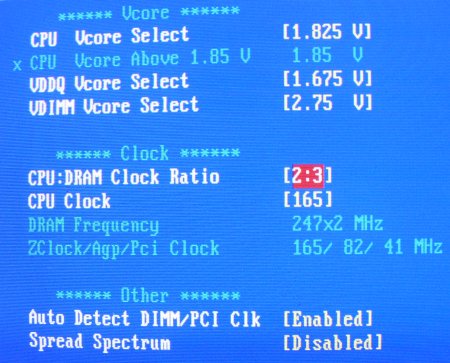BIOS
The increasingly common AMIBIOS makes its appearance on the AS45GTR. Let's have a look at the main configuration screen.

CPU voltage can be set from 1.1v to 1.825v in 0.025v increments, handy for fine-tuning your required voltage. There's a reference to voltages greater than 1.85v but I couldn't implement it, not that I would want to with a Pentium 4 Northwood processor. Video card voltage can be manipulated from the standard 1.5v to 1.675v, presumably to add a little stability to various video cards. Memory voltage can be adjusted from 2.55v to 2.75v in 0.05v increments, too.
The CPU FSB clock can be changed from 100 - 165FSB in 1MHz increments. With other motherboards offering sky-high 200FSB+ support, this seems a little conservative. The CPU:DRAM ratio defines at what relative speed the system memory operates at with respect to the CPU FSB clock. From 100 - 132 CPU FSB, you can set the memory speed to either 1:1, 3:4, 3:5, or 1:2, giving you DDR-200, DDR-266, DDR-333, and DDR-400 support at 100FSB. At 133 - 165FSB, your ratios change to accommodate the faster CPU FSB. 4:3, 1:1, 4:5, and 2:3 ratios available. These serve to offer the same memory speeds as the 100FSB options, albeit different ratios are needed.

That's the first time I've seen Serial ATA make an appearance in a BIOS. The plethora of features can be manipulated from this configuration screen. It's nice to see 2 types of RAID, USB2.0, Firewire, and decent sound all make it on to one motherboard.

The DDR timings screen is relatively limited but does the job. DRAM CAS latency can either be set to CL2 or CL2.5. The system performance modes make everything easy for the novice user. You're given options for Safe, Normal, Fast, Turbo, and Ultra timings. Lastly, the Address Command rate can be set to the performance-enhancing 1T rate. Armed with a stick of Corsair XMS3200 C2 memory, I chose these timings for testing at the supported 166MHz memory speed.
The rest of the BIOS is standard fare. It's robust, tweakable, and has more than a passing resemblance to an ABIT BIOS, no bad thing in my book.









